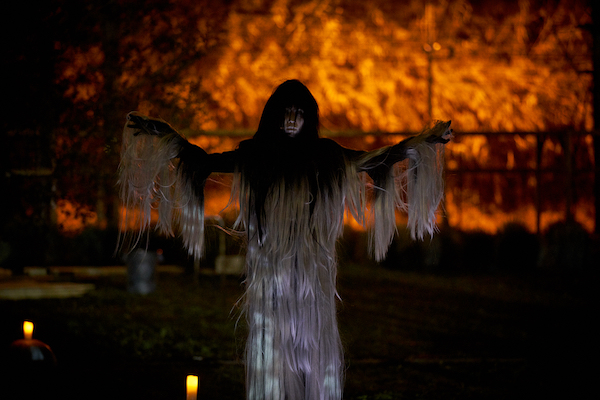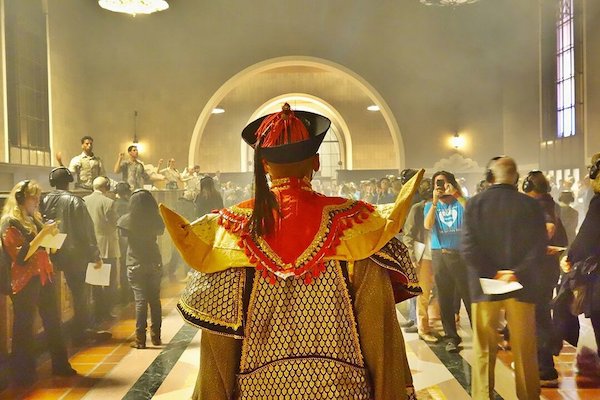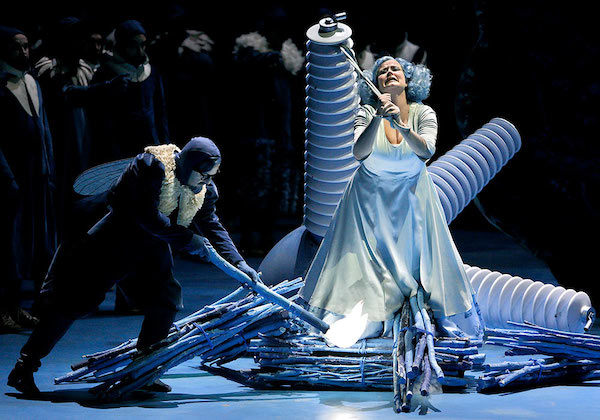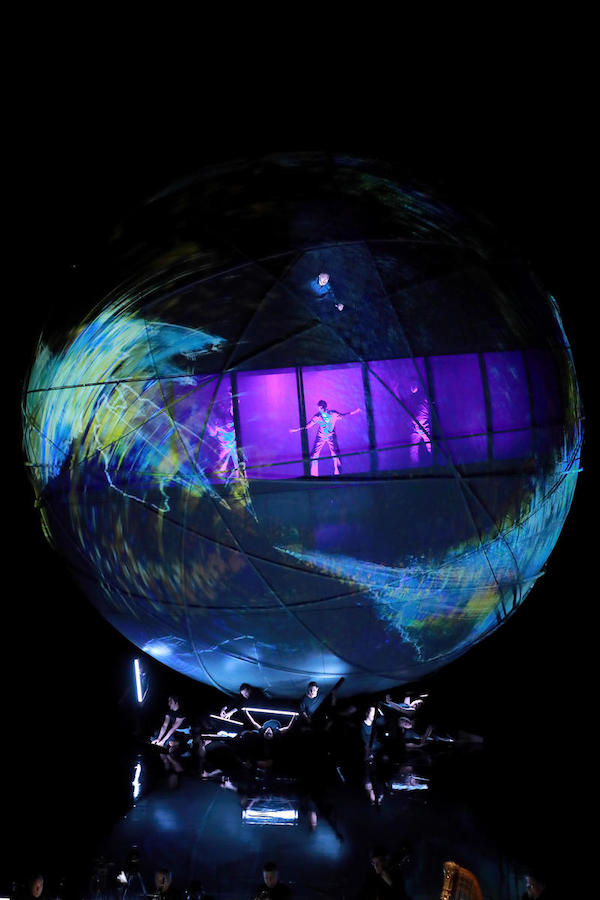¤
OPERA IS AN ephemeral endeavor, a balancing act of all the art forms: poetry, design, dance, acting, drama, architecture, fashion, and music. This ephemerality is part of opera’s allure, but it comes together all too rarely: one night out of 100 if you are lucky. Read on for the improbable, dizzying tale of how one of these singular operatic events came about. How in less than 10 years, one Angeleno went from opening his funky new music project in a tiny arts space in Atwater Village to occupying the director’s seat of one of the most famous theaters in the world — and then how he risked it all to make Los Angeles the site of the operatic event of 2020.
¤
Yuval Sharon has directed at the biggest opera houses in Berlin and Vienna, but in the last few months, the 40-year-old Los Angeles resident has been mostly in Southern California preparing his latest piece for The Industry, the opera company he founded eight years ago.
During a recent afternoon rehearsal at a former nightclub in the West Adams neighborhood, I observed Sharon explain to a group of singers why they are walking around in a circle. “It’s a zoetrope,” he explained, “it goes around once, and each time it’s like one flip-book.” They are rehearsing Sharon’s latest opus, Sweet Land, which he co-directed with Cannupa Hanska Luger. Described as “an opera that erases itself,” the widely anticipated Sweet Land prioritizes collaboration and features Native American artists. The music, for example, was composed by Creative Capital artist Raven Chacon and Pulitzer Prize–winning composer Du Yun, and the libretto was written by Aja Couchois Duncan and Douglas Kearney. Its premiere last month attracted the attention of the national media, which described it with words such as “mesmerizing” and a “masterpiece.”

In early 2012, I was at lunch with someone who is one of the pillars of the Southern California opera community. He mentioned casually: “You really have to check out the new thing by this guy Yuval Sharon. He’s a comer.” So a few weeks later, I schlepped up to Atwater Crossing to see Crescent City, which was billed as a “hyperopera.” The space was, to put it politely, modest. Despite covering performing arts in Los Angeles for over a decade, I had never been to it before.
It didn’t feel like going to the opera: no one was seated, everyone — including the performers — milled around these big, Red Grooms–like sculptures. “It was more an operatic happening,” I wrote at the time,
a gothic, if impenetrable southern tale that featured twins eating fried chicken and lines like “I took too much Viagra.” Yuval Sharon’s staging — more art installation, really — was visually raucous and always cheeky — even if it was rarely coherent. That said, the singers (many of them veterans of LA Opera productions) seemed to be having fun and the whole thing had the feel of a passion project.
Crescent City ran for three weeks that May and then was done. It didn’t seem like it was going to change the world. The august magazine for which I wrote those lines cut them out of my column that ran the following month.
¤
Sharon’s next piece, about a year and a half later, started to draw the attention of critics and operagoers. In 2013, Sharon staged an adaptation of Italo Calvino’s Invisible Cities in Union Station. The 1972 novel is a dialogue between explorer Marco Polo and the emperor Kublai Khan detailing a series of fantastic cities. Sharon suggests in his staging that the 55 fictional cities in the novel are no different from the many destinations to which one can travel from downtown Los Angeles — that for many operagoers at least, the notion of what lies at the end of the Gold Line or the Metrolink is as speculative as what an aging ruler knew of his vast kingdom. Drawing attention to the “unseen” city, in combination with the interactive, immersive format of the production, Sharon’s Invisible Cities, like Calvino’s, is a reminder that even Los Angeles is a city as personal as it is public, as imagined as it is real.
Despite the projection of Calvino’s text on the walls of the Art Deco landmark, the opera was hard to follow — literally. Audience members trailed the performers all over the station. The orchestra played in the café, and ticket holders were given headphones to hear the music as they wandered, watching the singers and dancers (from L.A. Dance Project) perform. Those with headphones were encouraged to share with strangers in transit who otherwise had not anticipated witnessing an opera. It was quite a coup de théâtre — mounting a piece with 75 performers in an active environment during an evening commute.

Sharon’s next endeavor, Hopscotch, came in 2015. Named for the Julio Cortázar “choose your own adventure” novel Rayuela (1963), Hopscotch has since become Los Angeles mythology. It was, as it is simply known in L.A. parlance: “The Car Opera.” Alex Ross, in a long feature in The New Yorker, called it “a combination of road trip, architecture tour, contemporary music festival, and waking dream.” Boasting a million dollar budget, plus a huge cast and crew (including 24 cars), not to mention six different composers, Hopscotch was wild and head-spinning, but most of all, it was fun. Sharon worked with six librettists to whittle Cortázar’s 155 chapters down to 24 and distill the complex plot into an Orpheus-like tale of one female puppeteer (Lucha, played by about 20 different performers) and her surreal romance with a motorcycle-riding scientist (Jameson). With Hopscotch, however, story was secondary to the ways in which the opera’s structure asked audience members to see contemporary Los Angeles as a place that cannot be captured or even accurately evoked by traditional operatic forms. The city is too sprawling, containing too many different narratives.
In putting this massive collaboration together, Sharon did something special; he made it clear to the opera world that Los Angeles has its own style, one that both reflects and employs the city’s immensity and diversity.
At the same time, the Los Angeles Philharmonic had been slowly getting into the opera business, doing concert performances at Disney Hall with fancy window dressing, courtesy of big-name collaborators such as architects Frank Gehry and Zaha Hadid; and designers like the Rodarte sisters, Hussein Chalayan, and Azzedine Alaïa. Given the splash Sharon had made with Hopscotch, it was no surprise when that same year the Phil announced that he was joining them as their “artist-collaborator.”
Sharon’s three-year residency with LA Phil is key to understanding his growth as a director. He started in 2016 with smaller interactive and immersive pieces, like Nimbus, which took place in a Disney Hall stairwell; and then grew to mammoth proportions, culminating in 2017’s War of the Worlds, a reimagining of Orson Welles’s radio play from 1938, which starred Sigourney Weaver and took place simultaneously inside the concert hall and at other locations downtown. These projects were interesting, but they often seemed like variations on previous themes.
Where Sharon really came into his own at the Phil was finding discarded American operas from the recent past and reviving them. His mounting of California composer Lou Harrison’s sole opera Young Caesar was a landmark. Sharon took this opera, which premiered in Pasadena in 1971 (disastrously by all accounts), and made it feel like a local treasure. Young Caesar was musically ahead of its time, but not without flaws. Sharon helped prune the libretto and enhance the orchestrations. He then created a staging that both honored the progressive playfulness of its premiere and yet also pushed Young Caesar into our time — and hopefully beyond. There was only one performance, and it was magical. Thankfully, it was recorded for posterity.
Later in 2017, Sharon was named a MacArthur Fellow, and by this time, the big-money European opera world had taken notice. One early champion was Austrian conductor Franz Welser-Möst, who has led close to 100 new productions at the most prestigious opera houses and festivals in the world. He enlisted Sharon to collaborate on Leoš Janácek’s opera The Cunning Little Vixen. “When he told me the concept, I could not imagine how it could work,” Welser-Möst told me, “and it turned out to be a work of genius, one of the most moving things I’ve ever seen on an opera stage.” “But while many directors can have a strong vision,” Welser-Möst added, “Yuval, he knows how to follow through with it every step of the way. And that’s unusual.”
This partnership led to Vienna Staatsoper hiring Sharon to direct a new production of Peter Eötvös’s operatic adaptation of Anton Chekhov’s Three Sisters. Next came a revival of the opera of Lost Highway in Frankfurt. It was in the middle of all of this activity that one of the plumiest assignments in opera suddenly fell into Sharon’s lap: directing a new production of Lohengrin for the Bayreuth Festival in Germany.
Lohengrin had already been scheduled to open in July 2018. Artists Neo Rauch and Rosa Loy had been working on sets for years, and Latvian actor/director Alvis Hermanis was the intended director. When he withdrew from the project in 2016, the Wagner family called Sharon with a kind of Mission Impossible: stage a new production of someone else’s designs, for someone else’s concept, for one of the most high-profile (and high-pressure) opening nights of the season, in less than a year, and in German. No wonder the Wagners called the guy who had staged an opera with moving cars.
Despite these challenges, Sharon delivered an impressive Lohengrin. The performance I attended was the most well received of any I have seen at Bayreuth (where booing is almost expected at curtain calls). His skill at helming major international singers in an old-fashioned, proscenium theater was as assured as his directing of young local artists at quirky, Southern California stages. He also smartly tilted the opera so that it made the female characters, Elsa and Ortrud, more prominent in the drama, a shrewd touch that managed to make the opera feel fresh — and somehow didn’t ruffle the feathers of the very conservative Bayreuth Wagnerians.

Most opera success stories would end here: local director goes on to big major international triumph. We could tie everything up nicely by mentioning the fact that Wagner was what brought Sharon to Los Angeles in the first place, when he assisted German director Achim Freyer on his Ring Cycle in the late aughts. But Sharon’s story keeps going. His real passion project — and his best production to date — was yet to come.
¤
In 2019, he staged a revival Meredith Monk’s Atlas as the final piece for his LA Phil residency. Unseen for almost 30 years, Monk’s sprawling, wordless opera — a loose retelling of the story of Alexandra David-Néel, a female French explorer in the 1920s — was ready for its close-up. The New Yorker raved, calling the performances “incandescent,” and The New York Times hailed Sharon’s “lavishly glowing production.” It was a revelation, and three lucky audiences last summer saw the language of American opera rewritten in front of their eyes and ears. There were lots of cool design elements, including a giant turning orb designed by Es Devlin (the designer behind Kanye’s, Beyoncé’s, and Lady Gaga’s touring spectaculars) through which the performers traveled, but the real magic was simply Monk’s music and libretto, which employs nonverbal syllables and vocalese, melded with movement to tell a powerful story perfectly in sync with the themes of David-Néel’s writings, which focus on Far Eastern spirituality and the idea of travel as a metaphor for inner growth and vision. By setting Atlas in Disney Hall, where the audience could see the audience surrounding the action, Sharon forced viewers to contemplate how Los Angeles itself is both local and global, like the orb in which the characters travel: a place where strangers connect, where linear histories and disparate origins are less important than a collective destination.

"Atlas" (2019). Photograph taken by Craig Mathew/Mathew Imaging at the Walt Disney Concert Hall, provided courtesy of the Los Angeles Philharmonic Association.
What Atlas showed was that Sharon does not just direct operas, imposing fashionable concepts and ideas on to existing works. What he does, as well as any opera director today, is listen to what the operas say to us right now, what they can make us feel — and then he channels the voice inherent in the work and brings it to life on stage.
This approach made the 2020 premiere of Sweet Land such an event. What would the man whom the Gray Lady has called “opera’s disrupter in residence” disrupt next? Perhaps the very idea of Los Angeles itself.
If his previous projects asked participants to experience Los Angeles in new ways, Sweet Land discomfits the very privilege of getting to do so, focusing on Southern California’s history of settler colonialism. Set in the newly christened Los Angeles Historic State Park — on the site of a former Southern Pacific depot that was considered the “Ellis Island” of Southern California — Sweet Land is an outdoor, pop-up performance featuring a cast and crew of over 100. Like Hopscotch, it comprises different “tracks,” one titled “Feast,” the other titled “Train.” Both are captivating. “Train” is more impressionistic, “Feast” more narrative. However, the final scene of Sweet Land, which is the same regardless of which path you choose, is simply ravishing. When it was over, I canceled my evening plans and stayed for the second performance of the night both to see it again and to experience both tracks. Sweet Land is The Industry’s first solo produced work since Hopscotch, and it is as ambitious and political in content as in its multi-tracked form.
¤
Back at the West Adams rehearsal, I watch Sharon move the handful of singers around in a circle, but I have no idea what the story is. At a break, he tells me a little about the “plot” and shows me a mock-up of the sets, which only makes me feel that I understand even less. When break is over, Sharon claps his hand together and calls out, “Work Song!” The performers all move back into a circle and continue to make strange, interesting sounds. It feels like no other opera rehearsal, but what I am watching is compelling. I want to see more. Sharon’s real talent just might be making things that don’t look or sound like operas feel deeply operatic.
When I sit down on the bleachers at the Los Angeles State Historic Park two weeks later, I once again don’t feel like I am at an opera. When the early performance starts just before sunset, one musician rattles a ring of wrenches in his mouth and another plays a cymbal — the sounds I hear do not sound like opera either. Yet just over an hour later, in these same bleachers, I witness one of the most stunning and operatic scenes I have witnessed. Ultimately, Sweet Land is not just an opera that erases itself, but it is also an opera about the erasure of history — a parable that abstractly represents the violent history of colonization in Los Angeles and the plight of indigenous peoples in the United States.
¤
How did Sharon pull these projects off? I asked him point blank over coffee last December: What was one thing to which he could point that made The Industry succeed, both artistically and with audiences, when so many other Los Angeles troupes had failed over the past few decades? Unlike many maestros or magicians, who distract or dissemble when asked about their secrets, Sharon answered candidly that he tried to differentiate The Industry from other companies by letting work linger for longer than a mere weekend. “From Crescent City onward,” he said, “I’ve always said there’s going to be a minimum of a three-week run. I think in many ways it’s the main key to our success, even though it makes it so much more expensive, that extra time allows for people find you. If you don’t have three weeks, the difficult thing is you’re only talking to the people who already know about what you’re doing.”
The tragedy of Sweet Land is that due to COVID-19, Sharon’s crucial third weekend had to be canceled. “Between weekend one and weekend two, we started to think about how to let people know that the park was safe,” Sharon recounted after the final performance: “That went well, people felt safe since it was only 200 people and outside. People were planning to come back.”
After the good reviews, a fourth weekend was added, but as the third weekend approached, Sharon describes the mood as “this roller-coaster — hour by hour, it was shifting, and then Thursday, when the governor said no gatherings over 250 people, and other organizations were all shutting, we realized we couldn’t be some lone holdout. That was it.”
Luckily, there was a plan to film the final performance, but could they move it up in time to accommodate newly interested audiences and current disappointed ticket holders? “We had to figure out a solution — it was a scramble. We talked to the cast and crew about wanting to film as a way to preserve it. We said can be surgical and we can be safe. Most everyone signed on. We ran it twice,” he said with a sigh. They filmed it without an audience: “It was social distancing and opera — which are very strange bedfellows.”
Sweet Land was recorded by a film crew and will be able to be experienced in its entirety in this new form. Sharon is still processing just how all this will affect his career, The Industry, and opera as an art form. “Everything we do is a risk. This was a hire-wire act in a way we hadn’t done before,” he laughs. “It was agonizing but yet inspiring to see it come together.”
This ending is painful, but unsurprising. To reiterate, opera is ephemeral. The word “ephemeral” comes from the Greek ephemeros, meaning “lasting only one day.” Sweet Land only lasted five nights, but it will live on. “I only realized at the end of the process,” Sharon adds as we wrap up our last interviews, “this piece is really about survival.” He is right.
Thanks to the same viral force that closed Sweet Land, there is no live opera in any of the grand theaters around the world right now. There is only streaming. Luckily, here is Sweet Land.
¤
James C. Taylor is the Southern California correspondent for OperaMagazine and a frequent contributor to the Los Angeles Times, The Economist, New Jersey Star-Ledger, and other publications. He was twice nominated for a Los Angeles Press Club Award for his radio programs about the performing arts in L.A.
LARB Contributor
LARB Staff Recommendations
Korngold’s Operatic Dreamscapes
Erich Wolfgang Korngold’s “The Dead City” comes to life at La Scala.
A Brecht for Our Time: On “The Collected Poems of Bertolt Brecht”
Yuval Sharon reviews the massive "The Collected Poems of Bertolt Brecht," recently released by Liveright.
Did you know LARB is a reader-supported nonprofit?
LARB publishes daily without a paywall as part of our mission to make rigorous, incisive, and engaging writing on every aspect of literature, culture, and the arts freely accessible to the public. Help us continue this work with your tax-deductible donation today!
:quality(75)/https%3A%2F%2Fdev.lareviewofbooks.org%2Fwp-content%2Fuploads%2F2020%2F03%2FTaylorSharon.png)